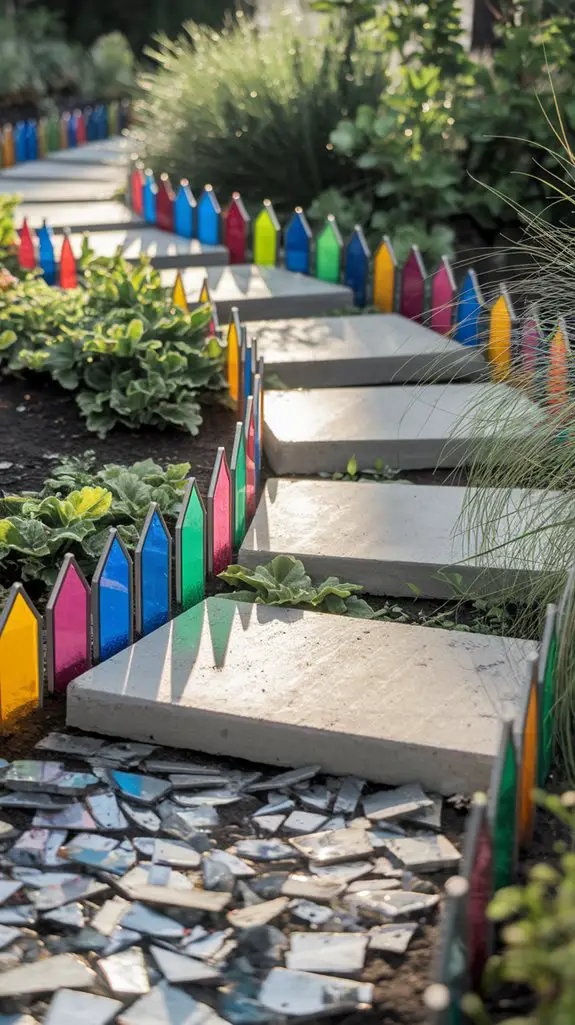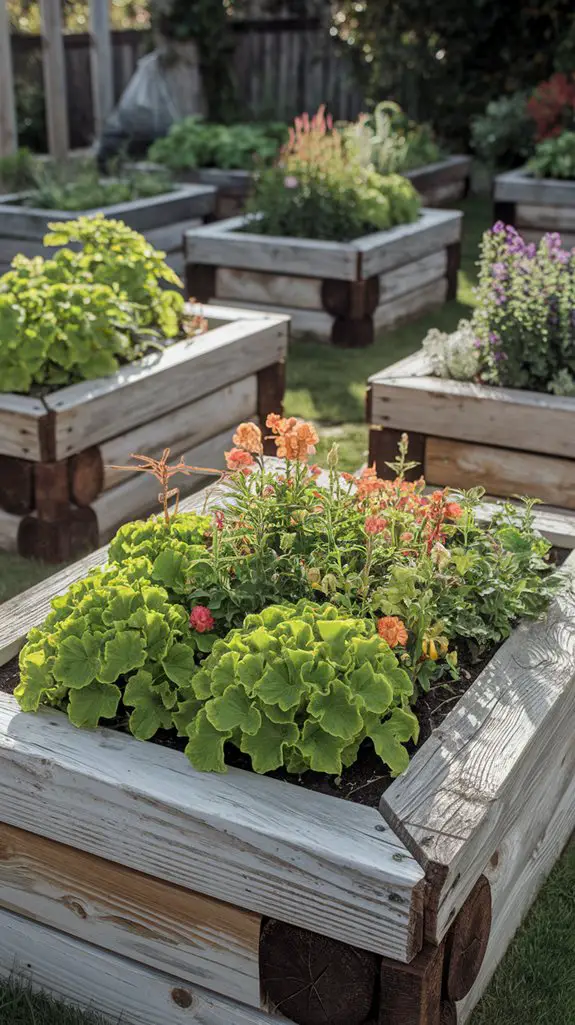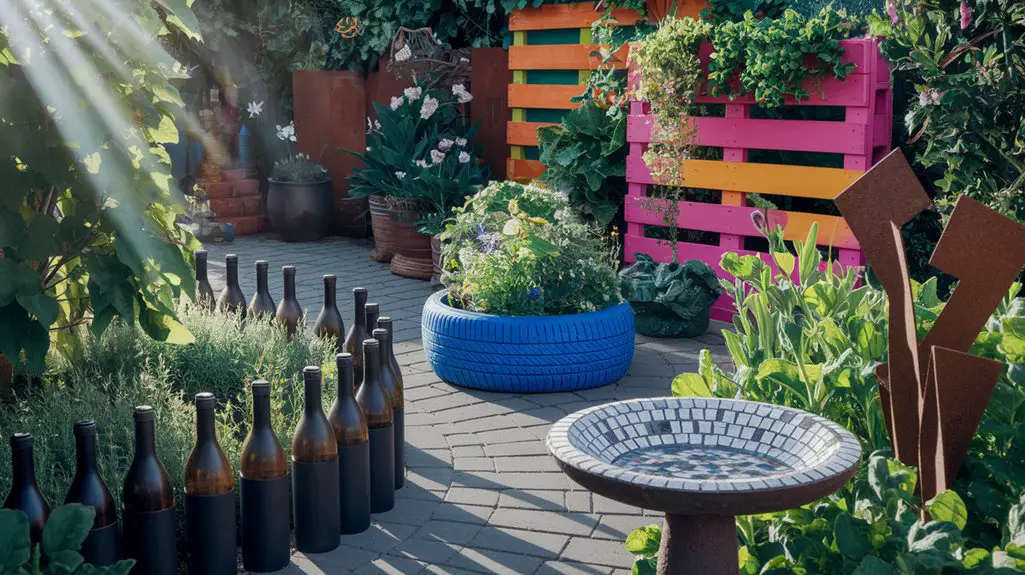Imagine stepping into a garden where yesterday's forgotten items bloom with new purpose. You don't need expensive materials to create a stunning outdoor space—your trash might actually be your garden's treasure. By incorporating recycled elements, you'll reduce waste while adding character and charm that mass-produced items simply can't match. Wondering how to transform discarded objects into garden features that are both beautiful and sustainable? These five approaches will show you exactly how to start.
Transform Old Containers Into Unique Planters
Five everyday household items can be transformed into stunning planters with minimal effort. Old teapots, wooden crates, worn boots, tin cans, and plastic bottles all offer excellent opportunities for creative gardening.
Before repurposing, make sure containers are clean and drill drainage holes in the bottom to prevent root rot. For plastic bottles, cut off the top portion and sand any sharp edges. Teapots work wonderfully for small herbs, while wooden crates can host multiple plants in a rustic display.
Don't overthink aesthetics—sometimes the most charming planters embrace their imperfections. Mason jars make perfect homes for succulents, while old toolboxes accommodate trailing vines beautifully. Incorporating eco-friendly materials like these not only enhances your garden but also supports sustainable practices.
You'll reduce waste, save money, and add personality to your garden with these simple upcycling projects.
Create Garden Paths With Recycled Construction Materials

Discarded construction materials that would otherwise end up in landfills can be repurposed into stunning, durable garden pathways with minimal cost. Look for broken concrete slabs (urbanite), used bricks, stone remnants, or ceramic tile scraps from demolition sites or renovation projects.
For a cohesive look, arrange similar-sized pieces in a repeating pattern, or create a mosaic effect with varied materials. Set your chosen materials in a base of sand or fine gravel to prevent shifting and allow proper drainage. Fill gaps between larger pieces with small pebbles, crushed granite, or drought-resistant groundcover.
You'll need to prepare the pathway area by removing vegetation, laying landscape fabric to block weeds, and adding a 2-inch layer of sand before placing your recycled materials. This approach not only reduces waste but creates character-rich pathways that improve with age, making it a great example of sustainable garden design.
Build Raised Beds From Salvaged Wood

Much like reclaimed construction materials can transform garden pathways, salvaged wood presents a perfect opportunity for creating raised garden beds that are both environmentally responsible and budget-friendly.
Look for weathered fence boards, wooden shipping pallets, or discarded lumber from renovation projects—just avoid pressure-treated wood that might contain harmful chemicals. Before building, remove any nails or staples, and lightly sand rough edges for safety.
Stack and secure your wood pieces in a rectangular formation, reinforcing corners with metal brackets or wooden stakes. For longevity, line the interior with landscape fabric to create a barrier between soil and wood.
You'll extend your bed's lifespan while keeping construction waste out of landfills. The natural weathering of salvaged wood adds rustic charm to your garden while providing ideal growing conditions for vegetables, herbs, and flowers. Additionally, raised garden beds can improve soil drainage and aeration for your plants.
Design Water Features Using Repurposed Items
Water features don't require purchasing expensive new components when your home and neighborhood are filled with potential treasures waiting to be transformed.
With a bit of creativity, you'll create soothing water elements while keeping materials out of landfills.
- Convert old ceramic sinks or bathtubs into charming miniature ponds – just seal any drain holes and add aquatic plants.
- Repurpose cracked pottery into stunning tiered fountains by stacking different sizes and running tubing through the center.
- Transform galvanized metal containers, old watering cans, or industrial spigots into unique water spouts.
- Use salvaged copper pipes as water channels in a bamboo-style fountain that creates peaceful trickling sounds.
The key is waterproofing your found items properly and ensuring a sustainable water circulation system. Incorporating eco-friendly materials not only enhances your garden's aesthetic but also promotes environmental stewardship.
Craft Garden Art and Accessories From Discarded Objects
Your garden can become an artistic canvas where everyday castoffs transform into eye-catching decorative elements that express your personality while reducing waste.
Look for items with interesting shapes or patinas—old silverware becomes wind chimes, chipped teacups create whimsical bird feeders, and broken pottery forms colorful mosaic stepping stones.
Consider repurposing wooden pallets into vertical planters, transforming bicycle wheels into trellises, or hanging vintage colanders as unusual hanging baskets.
Metal objects like old tools, springs, or gears can be welded into sculptures that develop character as they weather. Glass bottles create striking borders or light-catching garden walls when embedded in mortar. Additionally, incorporating stylish shade solutions can enhance the ambiance of your recycled garden art.
Before crafting, clean items thoroughly and remove any harmful components like lead paint or sharp edges to guarantee your recycled art remains safe for visitors and wildlife.
Conclusion
Just as the forest transforms fallen logs into nurseries for new life, you're now equipped to turn yesterday's discards into tomorrow's garden treasures. You'll not only save money and reduce waste, but you'll create a space uniquely yours. Your garden becomes a living allegory—where what's been forgotten finds purpose again. Each recycled piece tells a story, creating a sustainable sanctuary that nurtures both planet and soul.




